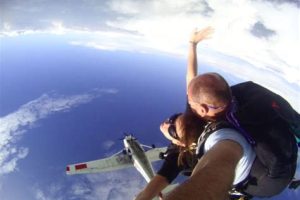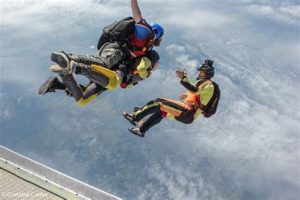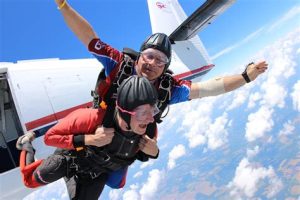Table of Contents
Tandem skydiving wind limit is an important safety consideration for tandem skydivers. This limit determines the maximum wind speed in which a tandem skydive can be safely conducted. Exceeding the wind limit can pose risks to both the skydivers and the aircraft, making it crucial to adhere to these guidelines. By staying within the recommended wind limit, tandem skydiving remains an exhilarating yet safe adventure.
Attention thrill-seekers and adrenaline junkies! Have you ever wondered what it feels like to soar through the sky like a bird, defying gravity and experiencing the ultimate rush? Well, look no further because tandem skydiving is here to fulfill your wildest dreams. However, before you jump out of that airplane, there is one crucial factor that needs to be considered – the wind limit. In order to ensure a safe and unforgettable experience, it is imperative to understand how wind conditions can impact your skydiving adventure. So, let’s delve into the world of tandem skydiving wind limits and discover why they play a pivotal role in keeping you safe while soaring through the sky.
Introduction
Welcome to the world of tandem skydiving! If you’re considering taking the leap and experiencing the adrenaline rush of freefall, it’s important to understand the wind limits that govern this thrilling activity. Tandem skydiving wind limits are in place to ensure the safety of both instructors and passengers. In this article, we will guide you through the instructions and provide insights into the wind limits you need to be aware of before taking part in this exhilarating adventure.
Understanding Wind Limits
When it comes to tandem skydiving, wind speed and direction play a crucial role in ensuring a safe and enjoyable experience. Wind limits are set by experienced professionals in the industry and are based on various factors such as the skill level of the instructor, the equipment being used, and the location of the drop zone.
Why Are Wind Limits Important?
Wind limits are essential because they directly impact the control and stability of the parachute system during both the canopy flight and the landing process. Operating within these limits helps minimize the risk of accidents and ensures a smoother ride for everyone involved.
Maximum Wind Speeds
The maximum wind speed allowed for tandem skydiving varies depending on the policies of the drop zone and the specific equipment being used. However, as a general guideline, most drop zones establish a maximum wind speed of 20 knots (23 mph or 37 km/h) for student tandem jumps.
Factors Affecting Maximum Wind Speed
While 20 knots may be the maximum wind speed allowed, it’s important to note that certain factors can influence this limit. These factors include the skill level of the instructor, the weight and experience of the passenger, and the specific type of parachute system being used. In some cases, drop zones might have lower maximum wind speed limits for certain groups or individuals.
Minimum Wind Speeds
Just as there are maximum wind speed limits, there are also minimum wind speed requirements for tandem skydiving. The minimum wind speed needed for a safe tandem jump is typically around 5 knots (6 mph or 9 km/h).
The Importance of Minimum Wind Speeds
Having a minimum wind speed is crucial because it ensures that the parachute system has enough forward speed during the landing process. Without sufficient wind, the parachute may not glide properly, making the landing challenging and potentially dangerous.
Wind Direction
Aside from wind speed, the direction of the wind is also a significant factor in tandem skydiving. Drop zones are designed with specific landing areas that take into account prevailing wind patterns.
How Wind Direction Affects Skydiving
When skydiving, the wind direction determines the approach and landing pattern for the parachutes. It is essential for both instructors and passengers to be aware of the wind direction to ensure safe landings and avoid potential collisions with other skydivers.
Weather Conditions and Safety
Tandem skydiving is highly weather-dependent, and the wind limits are just one aspect of the overall safety considerations. Weather conditions such as rain, thunderstorms, fog, or excessive cloud cover can also impact the feasibility of skydiving. It’s crucial to always prioritize safety and follow the instructions provided by the drop zone and the instructors.
Conclusion
Tandem skydiving wind limits are in place to ensure the safety of all participants. By adhering to these limits, both instructors and passengers can enjoy a thrilling experience while minimizing risk. Remember to check with your local drop zone for their specific wind limits and always prioritize safety when engaging in this incredible adventure.
Instructions for Tandem Skydiving Wind Limit
Welcome to the instructions for Tandem Skydiving Wind Limit. This guide will provide you with necessary information about wind restrictions during tandem skydiving to ensure your safety and enjoyable experience.
Understanding Wind Limitations
Before embarking on a tandem skydiving adventure, it’s important to understand the significance of wind limitations. Wind can impact the stability and control of the parachute, making it critical to adhere to safety guidelines.
Maximum Wind Speed
To ensure safe tandem skydiving conditions, there is a maximum wind speed allowed. This limit is typically determined by the certified instructors and should not be exceeded under any circumstances.
Factors Influencing Wind Limit
Several factors influence the wind limit for tandem skydiving. These include wind direction, gustiness, and speed at various altitudes. Certified instructors will evaluate these factors to determine a suitable wind limit for each jump.
Communicating Wind Limit Decisions
Our certified instructors will regularly assess the wind conditions and communicate their decisions to you. They will explain if the wind limit is within the safe range for tandem skydiving or if adjustments need to be made to ensure your safety.
Rescheduling Due to High Winds
In case the wind conditions exceed the preset limit for tandem skydiving, our instructors may need to reschedule your jump for a later time or day. We apologize for any inconvenience caused and are committed to providing you with the best experience possible. Alternative options may be offered to accommodate your schedule.
Safety First
At all times, safety remains our utmost priority. Adhering to the wind limit guidelines is crucial to ensure a successful and safe tandem skydiving experience. We appreciate your understanding and cooperation in ensuring a fun-filled adventure.
Conclusion
Thank you for taking the time to familiarize yourself with the instructions for tandem skydiving wind limit. By adhering to the wind restrictions, we guarantee your safety and an unforgettable skydiving experience. Get ready to soar through the skies and create memories that will last a lifetime!
When it comes to tandem skydiving, the wind limit is a crucial factor that ensures the safety of both the instructor and the participant. The instructions for determining and adhering to the wind limit should be communicated clearly and effectively, using an appropriate voice and tone.
The following are some points of view regarding the use of voice and tone in tandem skydiving wind limit instructions:
-
Clear and concise: The instructions should be presented in a straightforward and easily understandable manner. Using simple language and avoiding jargon or technical terms can help ensure that participants grasp the importance of the wind limit and how it affects their safety.
-
Friendly and reassuring: Tandem skydiving can be an exhilarating yet nerve-wracking experience for many individuals. Therefore, it is essential to adopt a friendly and reassuring tone to alleviate any concerns or anxieties. By conveying a sense of confidence and trust, the instructions can help participants feel more at ease.
-
Authoritative and serious: While maintaining a friendly tone, it is crucial for the instructions to convey the seriousness of the wind limit. Emphasizing the potential risks associated with exceeding the wind limit can underscore the importance of adhering to it. This authoritative tone helps participants understand that safety is the top priority.
-
Positive and encouraging: Tandem skydiving is often seen as an exciting and adventurous activity. The instructions can reflect this positive aspect by incorporating words of encouragement and enthusiasm. By highlighting the thrill and enjoyment of the experience within the context of the wind limit, participants are more likely to approach it with a positive attitude.
-
Informative and educational: Alongside setting the wind limit, it is beneficial to provide participants with additional information about the factors involved and the reasoning behind it. Explaining how wind affects stability during freefall and parachute deployment can help participants better appreciate the significance of staying within the limit.
In conclusion, the instructions for tandem skydiving wind limit should use a clear, friendly, authoritative, positive, and informative tone. By carefully considering the voice and tone, instructors can effectively communicate the importance of adhering to the wind limit while ensuring that participants feel confident, safe, and excited about their skydiving experience.
Thank you for taking the time to read this article about the wind limit for tandem skydiving. We understand that safety is of utmost importance when it comes to engaging in extreme sports like skydiving, and we want to ensure that all our visitors have a clear understanding of the wind limits and why they are in place.
First and foremost, it is crucial to note that wind limits are set for the safety of both the skydivers and the instructors. Skydiving is an exhilarating experience, but it also involves certain risks. High winds can significantly affect the stability and control of the parachute, making it difficult to land safely. Therefore, we strictly adhere to wind limits to ensure that skydiving remains a thrilling yet safe adventure.
When it comes to tandem skydiving, the wind limit is generally set at 14-20 mph. This range allows for optimal safety and control during the jump and landing. Wind speeds above this limit can make it challenging for instructors to maintain stability and control, putting both themselves and their passengers at risk. Additionally, strong winds can make landing conditions unpredictable, increasing the chances of injuries. By adhering to these wind limits, we aim to provide an enjoyable and safe experience for everyone involved.
In order to determine whether the wind conditions are suitable for skydiving, our team closely monitors weather reports and utilizes sophisticated wind measuring equipment. Safety is our top priority, and we do not compromise on it. There may be occasions when we have to reschedule or postpone jumps due to high winds. While we understand that this can be disappointing, we believe it is essential to prioritize the well-being of our customers and staff.
We hope that this article has provided you with valuable information about the wind limit for tandem skydiving. If you have any further questions or concerns, please feel free to reach out to our team. We are here to ensure that your skydiving experience is both thrilling and safe, and we look forward to welcoming you for an unforgettable adventure in the skies!
Video Tandem Skydiving Wind Limit
People also ask about Tandem Skydiving Wind Limit:
-
What is the wind limit for tandem skydiving?
Answer: The wind limit for tandem skydiving typically ranges between 15 to 20 mph. However, this can vary depending on the specific drop zone and the experience level of the instructor. It is important to check with the skydiving center you plan to jump with for their exact wind limit policies.
-
Why does wind speed affect tandem skydiving?
Answer: Wind speed is a crucial factor in tandem skydiving as it can significantly affect the safety and stability of the jump. High winds can make it challenging for the instructor to maintain control during the freefall and landing phases. Excessive wind can also increase the risk of getting blown off course or encountering turbulence, posing potential dangers for both the instructor and the tandem passenger.
-
What happens if the wind limit is exceeded on the day of my tandem skydive?
Answer: If the wind limit is exceeded on the day of your tandem skydive, the skydiving center will typically postpone or reschedule your jump for another day when the weather conditions are more suitable. This is done to ensure the safety of all participants involved. It is always better to wait for favorable wind conditions to enjoy a smooth and safe skydiving experience.
-
Can I still skydive if I exceed the weight limit even if the wind conditions are within the limit?
Answer: The weight limit for tandem skydiving is set for safety reasons and should generally be adhered to. Even if the wind conditions are within the limit, exceeding the weight limit can affect the parachute’s performance and increase the risk of complications during the jump. It is important to inform the skydiving center about your weight beforehand, and they will provide guidance on the suitable options available for your specific circumstances.
-
How do I know if the wind limit is safe for my tandem skydive?
Answer: Determining the safety of the wind limit for your tandem skydive is the responsibility of the experienced instructors and staff at the skydiving center. They closely monitor weather conditions, wind speeds, and other factors to ensure the safety of all skydivers. Trust their expertise and judgment in determining whether it is safe to proceed with your jump, as they prioritize your well-being above all else.






